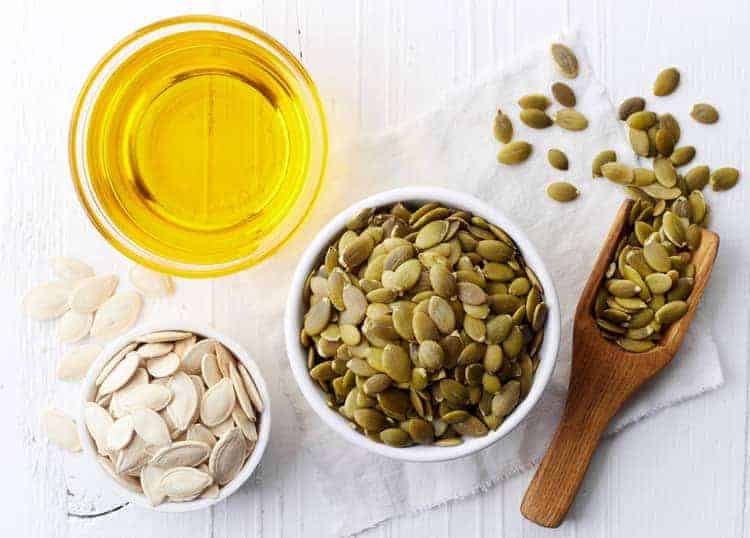
Can carrier oils actually do anything for hair growth, and if so, what are the best best carrier oils for hair loss and regrowth?
Well, this in this article we’re going to dive into this topic by looking at:
- studies that have been done on carrier oils and hair growth.
- some of the best oils to to consider using.
- how to incorporate these oils into your hair care routine.
Let’s get right to it!
Note: This post contains some affiliate links and I earn a commission (at no additional cost to you) if you use them to make a purchase.
LIST OF CARRIER OILS FOR REGROWING AND THICKENING HAIR

The first category of oils that may help with hair growth are the ones that are rich in omega-6 fatty acids and omega-3 fatty acids (collectively known as polyunsaturated fatty acids or PUFAs).
To start off, let’s talk first about omega-6 fatty acids:
- This subcategory includes linoleic acid and gamma-linolenic acid (GLA), both of which are associated with promoting hair growth (1, 2).
- One study found that topical application of pumpkin seed oil (rich in linoleic acid) increased hair growth in mice that had been treated with testosterone. If you’re wondering why testosterone was used, it’s because the conversion of testosterone to the hormone, DHT, is what contributes to hair loss. The study concluded that pumpkin seed oil might be a good remedy for male pattern baldness (source). Having said all this, we need more studies – particularly, human studies – to confirm that this remedy is truly reliable.
- The body needs linoleic acid in order to make arachidonic acid, which is a fatty acid that plays an important role in hair growth. In fact, one study found that topical application of safflower oil (also rich in linoleic acid) improved alopecia, scalp dermatitis (eczema) and loss of hair color. Furthermore, another study done with mice found that arichidonic acid elongates the anagen (aka active) phase of hair growth (source).
Now let’s look at omega-3 fatty acids:
- This subcategory has also shown promising results in human studies. However, most of the studies focused on the oral intake of omega-3, rather than topical application. So, even though topical application of these types of oils certainly has its benefits, there’s no research to help us understand the effect on hair growth.
Now that we’ve covered the basic research around fatty acids and hair growth, here’s a small selection of oils that you can add to your hair care routine.
| OIL | PROPERTIES |
|---|---|
| Safflower | – 55-77% linoleic acid. – Light weight. |
| Rosehip | – 54% linoleic acid – Light weight |
| Pumpkin seed | – 42.1–48.5% linoleic acid. – Rich consistency. |
| Prickly pear | – 61% linoleic acid. – Slightly viscous. |
| Grapeseed | – 66–75.3% linoleic acid – Very light weight |
| Hemp seed | – 55.64% linoleic acid. – Medium weight/consistency. |
| Borage | – 26-38% GLA and 35-38% linoleic acid. – Said to be the richest source of GLA. – Light weight. |
| Sunflower | – 44–75% linoleic acid. – Light weight. |
| Walnut | – 49-63% linoleic acid. – Medium weight consistency. |
| Cranberry seed | – The only oil with a good balance of omega 3, omega 6 and omega 9 fatty acids. – 35–40% linoleic acid, 30-35% alpha-linolenic acid, 20-25% oleic acid. – Medium weight/consistency. |
Aside from the oils listed above, other oils that are commonly used to support a healthy scalp and hair include castor oil and jojoba oil.
In the case of castor oil, jamaican black castor is very popular in hair growth products and there are anecdotal reports from people who rely on it for growing or thickening hair.
HOW TO MIX & USE CARRIER OILS FOR HAIR GROWTH: HOME REMEDIES TO TRY
If you are brand new to using carrier oils, start by mixing just two oils together. You can combine them in equal parts or you can use a higher amount of one versus the other.
As you get more comfortable with mixing oils, feel free to create your own signature blend with 3, 4 or oils.
To further boost the potency of the oils, you can also:
- Add a few drops of essential oils like rosemary, thyme or peppermint. They’ve all been shown to help with hair growth. For a complete guide on which oils to use read this guide on how to mix essential oils for hair growth.
- Infuse your oil(s) with herbs like amla, stinging nettle or horsetail. Not only do these herbs contain lots of nutrients, but they also inhibit 5-alpha reductase (the enzyme that drives the conversion of testosterone to DHT, contributing to alopecia). Use this guide on how to infuse oils in herbs for hair growth to learn about the various herbs that you can use.
Once you have your oil(s) ready to go, there are two ways to use it:
- Warm the oil in the palm of your hand and then massage it into your scalp for a few minutes.
- Gently heat up the oil to a comfortable temperature and use it as a hot oil treatment. Leave it on for at least an hour or overnight. Then shampoo it out.
OILS THAT YOU CAN BUY FOR HAIR LOSS & REGROWTH
1. Hair Growth Oil from EssyNaturals Advanced

This blend keeps things simple by focusing on four popular hair growth ingredients:
- castor oil.
- caffeine.
- rosemary oil.
- biotin (vitamin B5).
Based on the stellar reviews, it’s clear that this blend hits the mark.
Get this EssyNaturals hair growth oil here.
2. Donna’s Recipe Strength Hair Oil
Created by the popular influencer, Tabitha Brown, this hair oil has 1076 reviews, with 1033 of them 5 stars (at the time of writing this).
It contains 18 oils and powders that are said to extend the hair growth cycle. These include:
- jojoba oil.
- avocado oil.
- thyme oil.
- bhringaraj.
- chebe powder.
- grapeseed oil.
- rosemary oil.
The oil also comes in two versions: a standard (heavier oil) and a nut-free (and lighter) version.
Get Donna’s Recipe hair oil here.
CONCLUSION
The research on carrier oils and hair regrowth has mainly focused on polyunsaturated fatty acids like linoleic and gamma-linolenic acid.
Furthermore, some of these studies have been done only on animals or have looked exclusively at internal consumption.
So, carrier oils alone may not be enough to address hair loss. You’re likely better off using them with other natural remedies, like herbs and essential oils.
You Might Also Like:
Everything You Need To Know About Castor Oil vs Rosemary Oil for Hair Growth
Tea Rinses for Hair Growth: Beginner’s Guide with Top Herbs and Recipes
DIY Lavender Essential Oil Recipes for Hair Growth & Thickness
Rosemary vs Peppermint Oil for Hair Growth: Which Should You Use?
What To Mix With Shea Butter for Skin and Hair: Tips and Recipes
Rose Oil vs Rosehip Oil for Skin And Hair: Benefits | Which is Better | How To Use
Lightweight Oils for 4C Hair: Reduce Breakage and Promote Growth

